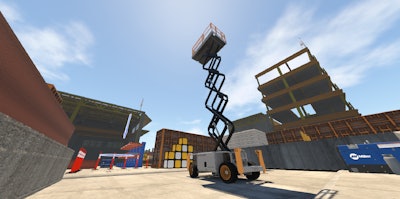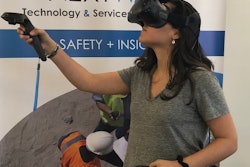
Editor’s note: The following report combines discussions held during the Skyjack/Serious Labs joint press conference at The Rental Show in New Orleans in February, and at the IPAF Summit in Miami in March. Comments have been edited for space and clarity.
- vir·tu·al re·al·i·ty (noun) The computer-generated simulation of a three-dimensional image or environment that can be interacted with in a seemingly real or physical way by a person using special electronic equipment, such as a visor or helmet with a screen inside, or gloves fitted with sensors.
Everyone’s heard the term virtual reality, but despite the relatively relatable state of the art, for many it still conjures up images of science fiction. In “reality,” the technology is becoming increasingly prevalent in our day-to-day lives. One area where this is particularly true is in equipment training.
The nature of aerial equipment has traditionally presented unique challenges to safe and effective training. Today, however, virtual reality promises to play a prominent role in the movement toward getting appropriate training to everyone who needs it, thanks in large part to the recent introduction of the MEWP Virtual Reality Training Simulator by Edmonton, Canada-based Serious Labs, which is working in partnership with Skyjack, United Rentals and Nationwide Platforms to develop its products and get them to the people who need them.
Getting serious about training
“Traditional, conventional training is somewhat flawed – and can be really boring,” says Jim Colvin, CEO of Serious Labs, which officially introduced its new simulator at the IPAF Summit in Miami in March. “Quite frankly, one reason people come into our industry is because they don’t like sitting in classrooms, they want to be physically engaged."
He continues, “The workforce is changing. There’s such a lack of skilled training in the world right now. How are we going to get through to young people about the workplace of the future unless we train them in the way they want to be trained? People learn by doing. It’s the best way to teach.”
Colvin points out that simulators are not new, they’ve been used in the military and aerospace for decades. But old-school simulators weren’t very engaging or experiential, and they were very expensive and not at all portable.
This began to change about five years ago, however, when Palmer Luckey, a college student from Long Beach, CA, developed the Oculus Rift, a virtual reality head-mounted display, making the technology more accessible and easier to use. He ultimately sold his creation to Facebook for $3 billion.
“They saw a massive revolution coming,” says Colvin. “And we’re just leveraging that.”
He continues, “We’re coming to a time where practical evaluation and assessment should move into virtual reality. An airplane pilot would never be able to get into a jet unless he had extensive hours of experience. We believe the same thing is true for heavy equipment. Everybody has the right to come home the way they left. Everybody’s family relies on them. Our mission is to create a better world with 21st century technology.”
Not really reality, but similar
A VR simulator is a completely immersive experience, Colvin explains. “You feel like you’re on an actual worksite, you can feel a visceral effect,” he says. “And it enables us to track everything the operator does. If you’re assessing someone from the ground and he’s up in a 150-foot lift, you don’t know where he’s looking. And how you judge compared to another instructor is not objective. A simulator is completely objective, however. It measures every way the operator leans, everywhere they look, how they do things and in what order.”
Wade Carson, director of business development at Serious Labs, says VR simulated training can be uniquely collaborative, bringing people in different parts of the world together in one place, virtually. “We bring an avatar into a virtual space," he says. "It’s a network that goes to the cloud. As long as you have somebody on the simulator, they can be in the same space at the same time.”
Darren Bechtel, managing director of Brick & Mortar Ventures, which has invested in the development of Serious Labs’ simulator, notes the value of this type of collaboration in the future of training. “We can actually simulate the exact scenario the operator will be operating in. No longer is it a fictitious world - it can be the actual jobsite, so when the operator shows up to that situation for the first time, it’s familiar.”
He continues, “We’re laying the groundwork for having not just simulated training environments, but this takes us one step closer to where an equipment operator could be halfway around the world from the worksite.”
Could VR replace practical training methods?
Currently, the best aerial equipment training programs consist of classroom or online theoretical training combined with a practical portion performed on the actual equipment, followed by evaluation by the instructor. While programs have come a very long way in recent years, there still has been no perfectly safe way to ensure operators get enough hands-on experience with machines to become truly proficient before they hit the jobsite.
“What if you could put people into dangerous situations, and be able to track their behaviors in those situations, but not actually put them in danger?” asks Colvin. “I personally believe VR should be mandatory in aerial equipment training. It’s ludicrous to suggest a pilot would ever be able to get into a plane without getting enough seat time, and this is no different. The ‘just enough, just in time’ training philosophy doesn’t work.”
Brad Boehler, president of Skyjack, which assisted Serious Labs in the development of its new simulator, says virtual reality has great potential for aerial equipment training, but stops short of suggesting it can replace on-machine practical training entirely. “I’m not sure if in five years we’ll get to where VR will fully replace practical training, but for ongoing training purposes, if we can actually look at what the operator’s skill set is in an actual operating environment, and evaluate how they react in that environment, that’s pretty invaluable,” he says. “I envision that as the next step.”
Giles Councell, director of operations at IPAF, says it’s important to keep in mind what the jobsite of the future will entail, including the real potential for remotely controlled or autonomous equipment. “When machines are controlled from the ground, simulators will be used even more,” he predicts. “The way to use it now is to put operators in really challenging scenarios on the actual machine without risk. That technology is here now, being used, and we need to look at how we can best use it in the short period of time we have to train operators, not just in the initial training but throughout their career.”
He adds, “One of the things simulation does is show the consequences of not following safe procedures on the jobsite. We all learn by mistakes but there can be dire consequences. Doing that in a virtual environment teaches operators what’s going to happen in a real environment, without the risk.”
Getting it into the hands of those who need it
Few can argue the potential benefits that virtual reality could bring to training and the jobsite of the future, but like all high-tech solutions, it’s questionable how accessible virtual reality simulators will initially be to those with fewer resources.
According to Boehler, the evolution will follow the same pattern as other impactful technological advancements, such as the smartphone, where technology became less expensive as scale increased, ultimately making it ubiquitous.
“Volume will drive down the cost to a place where VR can be more readily available to everyone,” he says. “But I also see the simulator of the future, which might be sort of a simulation of the simulator. It could be something on your phone that’s used with a cardboard box and a pair of gloves that you wear, but it will allow you to actually do the same thing. I see something like that allowing the technology to get to every corner.”
Bechtel echoes that statement with a comparison to today’s golf simulators. “Few of us have ever been on a true flight simulator, but a lot more of us have been on a golf simulator,” he says. “Professionals are training on the $75,000 version, where they can see the terrain of any golf course in the world. That same technology is used on mobile apps today. You obviously don’t get the feel of the golf club in your hands, but you can still go through that simulation to see what the course is like, and having that knowledge of the surroundings is very powerful. You don’t need the same capital but you can still benefit from some of that knowledge.”
Bringing the benefits of virtual reality to equipment operators everywhere is the ultimate goal, Colvin concludes. “It’s critical that we make sure this product is available,” he says. “It can’t be an elite product, it has to be a ubiquitous product. By working with IPAF, with its reach, and United Rentals, with its United Academy, we have the ability to get this out to the people who need it.”




















